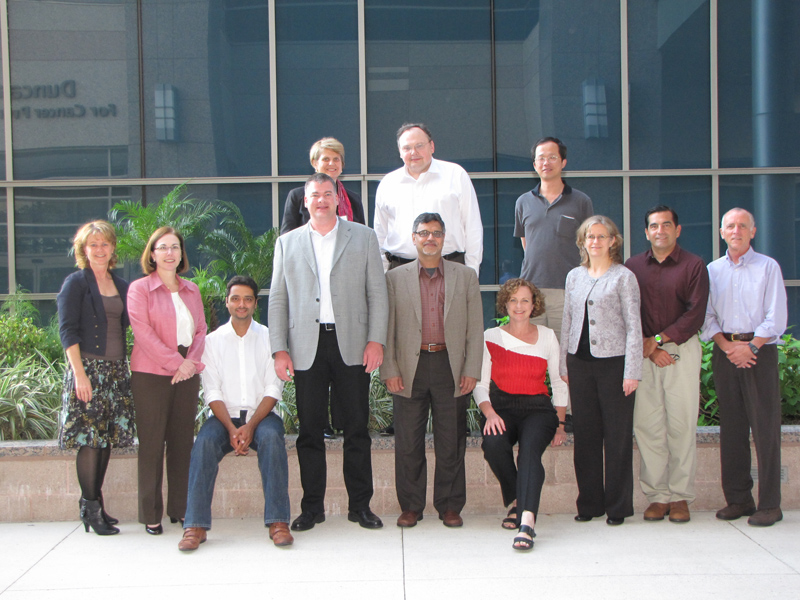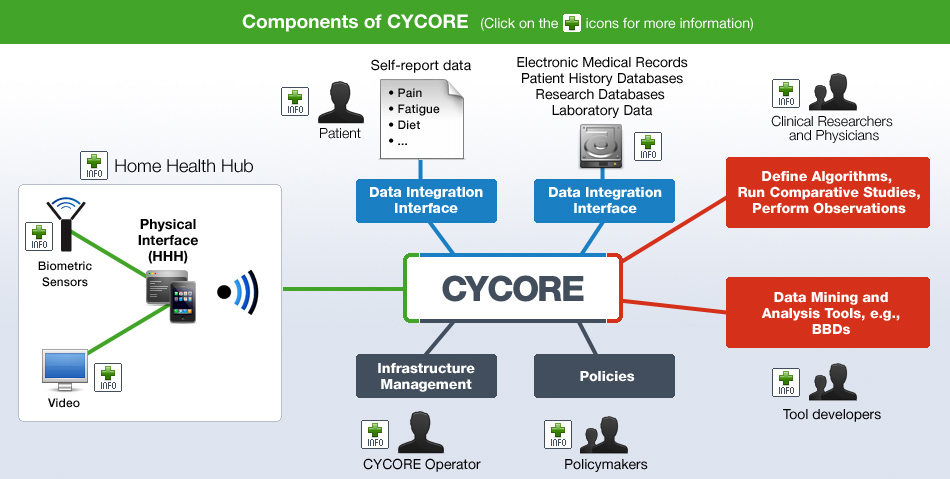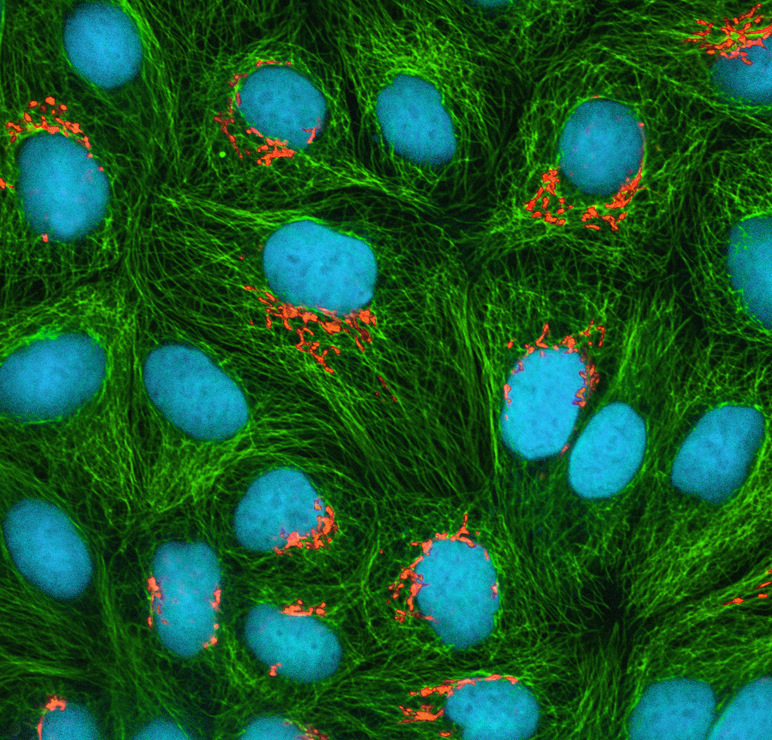CYCORE Tests System for Comparing Effectiveness of Cancer Treatments
San Diego and Houston, April 12, 2011 -- Researchers at the University of California, San Diego and clinicians at the MD Anderson Cancer Center in Houston have embarked on testing a new data system designed to determine which cancer treatments are most effective. The initial tests started this week, and they are designed to gauge how effective and easy-to-use the system is for physicians and patients enrolled in clinical trials of treatments for head-and-neck or colon cancer.
|
“Currently there is no viable system for compiling the many kinds of medical data acquired during clinical trials,” said Susan Peterson, CYCORE’s lead principal investigator and an associate professor at the University of Texas MD Anderson Cancer Center (MDACC). “Until CYCORE, trying to compare the effectiveness of cancer treatments was complicated by differing data formats, privacy issues, and the need to incorporate novel types of data. Now we will be able to draw more complete comparisons, including evaluations of the patient’s behavior and environment, which can influence treatment outcomes.”
The project – a collaboration among the UC San Diego division of the California Institute for Telecommunications and Information Technology (Calit2), MDACC in Texas, and the University of Alabama at Birmingham – was awarded $4 million over two years through a Grand Opportunity American Recovery and Reinvestment Act (ARRA) 'stimulus' grant from NCI. The project employs and partially funds 29 researchers at the three institutions.
The CYCORE team has now successfully completed and begun testing its first prototype system, which are now being used in four new clinical trials carried out at MDACC. For the head-and-neck or colon cancer patients, CYCORE has built an easy-to-use, integrated array of patient monitors and environmental sensors for blood pressure, heart rate, and weight, but also including a carbon monoxide meter to determine whether a patient continues to smoke, and an accelerometer to monitor physical activity. In addition, a GPS device will track patients’ movements outside the home, and a phone-based video system will assess their ability to carry out physical therapy. Patients can also inform clinical researchers of their overall well-being verbally via a digital survey presented on the same phone.
|
Furthermore, “physicians find it difficult to determine how cancer therapies affect the emotional states and stress levels of patients, and how they impact patients’ overall ability to function at home – properties which, in turn, can affect health outcomes,” said Kevin Patrick, MD, professor of family and preventive medicine at the UCSD School of Medicine, and CYCORE’s Principal Investigator. “Moving to more objective and continuous measurement of these behaviors and health states is essential if we are to understand fully the differences between alternative approaches to cancer treatment.” Patrick also directs Calit2's Center for Wireless and Population Health Systems (CWPHS).
In its first 12 months, CYCORE has made great strides in interfacing the biological and behavioral sensors with the project’s cyberinfrastructure (CI). CI is the software that stores and analyzes the data, and provides results to clinicians and researchers so that the data can be processed and analyzed. Although many such sensors are now available commercially, they are not adapted for easy, simultaneous data collection from patients in their homes, and their data are typically in widely differing formats. CYCORE’s “home health hub” – newly designed and completed at Calit2 – integrates the input from these environmental and medical sensors and smoothly transmits the data to the CI for analysis and use (see below).
|
CYCORE’s cyberinfrastructure is designed to optimize efficiency and flexibility of data access, collection and processing. A team from Calit2 and UC San Diego’s Computer Science and Engineering (CSE) department has architected and built the CI to quickly and effortlessly adapt to changing requirements, due to ever-evolving methods of data analysis and display, patient-privacy laws, instrument designs and sources of data. This capability eliminates the need to re-design the system each time an enhancement or policy change is incorporated.
|
Another key challenge in this domain is the handling of multi-format data. For example, digital readouts of blood-pressure data are not compatible with verbal responses to questionnaires, which in turn are very different from GPS data or video images. Such multi-format data can be difficult to combine and analyze efficiently because of the need to treat each data set differently. To solve this problem, Dr. Chaitan Baru’s research team at the San Diego Supercomputer Center (SDSC) has created novel data-processing algorithms to organize and sort the data for subsequent analysis.
In 2010, the MDACC registered nearly 10,000 participants in various clinical trials exploring novel treatments, the largest such program in the U.S., and the center supports multidisciplinary research in patient care and education. Complementing this clinical capability are the technological strengths found on the UC San Diego campus, including sensor development, wireless and wired communications, data processing, and cyber-system design, among others.
“Calit2 has made a serious commitment with Ingolf Krueger’s group to the development of software systems and cyberinfrastructure that can form the foundation of scientific discovery,” said Ramesh Rao, director of the UCSD division of Calit2. “By bringing that expertise together with the knowledge and experience in Kevin Patrick’s Center of Wireless and Population Health Systems at Calit2, and enabling collaboration with colleagues at MD Anderson, the CYCORE project has become an exemplar of how information technology can enable future discoveries, and not just in the medical field.”
CYCORE recently unveiled a new website devoted to public education and accountability. The site provides tools for patients and for clinical researchers. It also offers more information on the project and its personnel, and features nano-scale images of cancer cells taken by U.S. scientists. To learn more about CYCORE, contact information can be found here.
Media Contacts
Doug Ramsey, 858-822-5825, dramsey@ucsd.edu or Laura Wolszon/CYCORE, lwolszon@ucsd.edu
Related Links
CYCORE
CWPHS
MD Anderson Cancer Center
University of Alabama at Birmingham
Calit2
San Diego Supercomputer Center
UCSD Computer Science and Engineering





